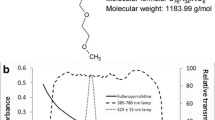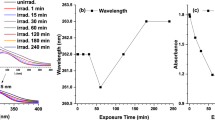Abstract
A number of Zn(ii)–phthalocyanines bearing peripheral substituents of cationic nature due to the presence of quaternarized anilinium or ammonium groups were shown to be efficient photoantimicrobial agents: a 4–5 log decrease in the survival of both wild-type or methicillin-resistant Staphylococcus aureus was obtained upon short irradiation times in the presence of phthalocyanine concentrations as low as 0.1 µM. A careful selection of the experimental protocol, and in particular the use of short (5 min) incubation times and mild irradiation parameters, allowed one to achieve a high selectivity of S. aureus photoinactivation as compared with important constituents of potential host tissues, such as human fibroblasts and keratinocytes. The efficiency and selectivity of the photoprocess were not affected by the presence of 5% human serum.
Similar content being viewed by others
References
D. Landman, N. Mobaraki, N. Quale and J. Novel, Novel antibiotic regimens against Enterococcus faecium resistant to ampicillin, vancomycin and gentamicin, Antimicrob. Agents Chemother., 1993, 37, 1904–1909.
G. A. Noskin, F. Siddiqui and V. Stosor, In vitro activities of linelizolid against important Gram-positive bacterial pathogens including vancomycin-resistant Staphylococci, Antimicrob. Agents Chemother., 1999, 43, 2059–2065.
S. Handerweger, B. Raucher and D. Altrac, Nosocomial outbreak due to Enteroccocus faecium highly resistant to vancomycin, penicillin and gentamicin, Clin. Infect. Diseases, 1993, 16, 750–755.
R. A. Gleckman and F. Borrego, Adverse reactions to antibiotics: clues for recognizing, understanding and avoiding them, Postgrad. Med., 1997, 101, 97–108.
G. B. Schreiber, M. P. Busch, S. H. Kleinman and J. J. Korelitz, The risk of transfusion-transmitted viral infection, New Engl. J. Med., 1996, 334, 1685–1690.
M. Wainwright, Photodynamic antimicrobial chemotherapy, J. Antimicrob. Chemother., 1998, 42, 13–28.
Z. Malik, J. Hanania and Y. Nitzan, Bactericidal effects of photoactivated porphyrins. An alternative approach to antimicrobial drugs, J. Photochem. Photobiol., B: Biol., 1990, 5, 281–293.
M. Merchat, G. Bertoloni, P. Giacomoni, A. Villanueva and G. Jori, Meso-substituted cationic porphyrins as efficient photosensitizers of Gram-positive and Gram-negative bacteria, J. Photochem. Photobiol., B: Biol., 1996, 32, 153–157.
A. Minnock, D. I. Vernon, J. Schofield, J. Griffiths, J. H. Parish and S. T. Brown, Photoinactivation of bacteria. Use of a cationic water-soluble zinc-phthalocyanine to photoinactivate both Gram-negative and Gram-positive bacteria, J. Photochem. Photobiol., B: Biol., 1996, 32, 159–164.
G. Bertoloni, F. Rossi, G. Valduga, G. Jori and J. van Lier, Photosensitizing activity of water- and lipid-soluble phthalocyanines on Escherichia coli, FEMS Microbiol. Letters, 1990, 71, 149–156.
Z. Malik, H. Ladan and Y. Nitzan, Photodynamic inactivation of Gram-negative bacteria: problems and possible solutions, J. Photochem. Photobiol., B: Biol., 1992, 14, 261–266.
A. Grellier, R. Santus, E. Mouray, V. Agmon, J. C. Maziére, D. Rigomier, A. Dagan, S. Gatt and J. Schrevel, Photosensitized inactivation of Plasmodium falciparum and Babesiaolivergens-infected erythrocytes in whole blood by lipophilic pheophorbide derivatives, Vox Sanguinis, 1997, 72, 21–220.
M. R. Hamblin and B. Ortel, Future directions in PDT. Photosensitizer targeting and new disease indications, in Photodynamic Therapy and Fluorescence Diagnosis in Dermatology, ed P. G. Calzavara-Pinton, R. M. Szeimies and B. Ortel, Elsevier Science Publ., Amsterdam, 2001, pp. 339–366.
M. Wilson, Photolysis of oral bacteria and its potential use in the treatment of caries and periodontal diseases, J. Appl. Bacteriol., 1993, 78, 299–306.
K. Berg, Mechanisms of cell damage in photodynamic therapy, in The Fundamental Basis of Phototherapy, ed H. Honigsmann, G. Jori and A. E. Young, OEMF, Milan, 1996, pp. 181–207.
D. Dei, M. P. De Filippis, L. Fantetti, G. Chiti, M. Soncin, A. Busetti, F. Giuntini, G. Jori, and G. Roncucci, Phthalocyanines as photodynamic agents for the inactivation of microbial pathogens, J. Med. Chem. submitted for publication.
S. Rasheed, W.A. Nelson-Rees, E. M. Toth, P. Arnstein and M. B. Gardner, Characterization of a newly derived human sarcoma cell line (HT-1080), Cancer, 1974, 33, 127–133.
P. Boukamp, R. T. Petrussevska, D. Breitkreutz, J. Hornung, A. Markham and N. E. Fusenig, Normal keratinization in a spontaneously immortalized aneuploid human keratinocyte cell line, J. Cell Biol., 1988, 106, 761–771.
P. K. Smith, R. I. Krohn, G. T. Hermanson, A. K. Mallia, F. H. Gartner and M. D. Provenzano, Measurement of protein using bicinchoninic acid, Anal. Biochem., 1985, 150, 76–85.
J. E. van Lier and J. D. Spikes, The chemistry, photophysics and photosensitizing properties of phthalocyanines, in Photosensitizing Compounds: Their Chemistry, Biology and Clinical Use, ed G. Bock and S. Barnett, CIBA Foundation Symposium 146, London, 1989, pp. 17–26.
M. Merchat, J. D. Spikes, G. Bertoloni and G. Jori, Studies on the mechanism of bacteria photosensitization by meso-substituted cationic porphyrins, J. Photochem. Photobiol., B: Biol., 1996, 35, 149–157.
G. Jori, Photodynamic therapy for the treatment of microbial infections, Photodynamic News, 1999, 2, 2–3.
G. Jori and E. Reddi, The role of lipoproteins in the delivery of tumour-targeting photosensitizers, Int. J. Biochem., 1993, 25, 1369–1375.
G. Valduga, A. Pifferi, P. Taroni, G. Valentini, E. Reddi, R. Cubeddu and G. Jori, Steady-state and time-resolved spectroscopic studies on low-density lipoprotein-bound Zn(II)-phthalocyanine, J. Photochem. Photobiol., B: Biol., 1999, 49, 198–203.
C. E. Millson, W. Thurrell, G. Buonaccorsi, M. Wilson, A. J. MacRobert and S. G. Bown, The effect of low power laser light at different doses on gastric mucosa sensitized with methylene blue, haematoporphyrin derivative or toluidine blue, Lasers Med. Sci., 1997, 12, 145–150.
M. R. Hamblin, D. A. O’Donnell, N. Murthy, C. H. Contag and T. Hasan, Rapid control of wound infections by targeted photodynamic therapy monitored by in vivo bioluminescence imaging, Photochem. Photobiol., 2002, 75, 51–57.
Author information
Authors and Affiliations
Corresponding author
Rights and permissions
About this article
Cite this article
Soncin, M., Fabris, C., Busetti, A. et al. Approaches to selectivity in the Zn(ii)–phthalocyanine-photosensitized inactivation of wild-type and antibiotic-resistant Staphylococcus aureus. Photochem Photobiol Sci 1, 815–819 (2002). https://doi.org/10.1039/b206554a
Received:
Accepted:
Published:
Issue Date:
DOI: https://doi.org/10.1039/b206554a




